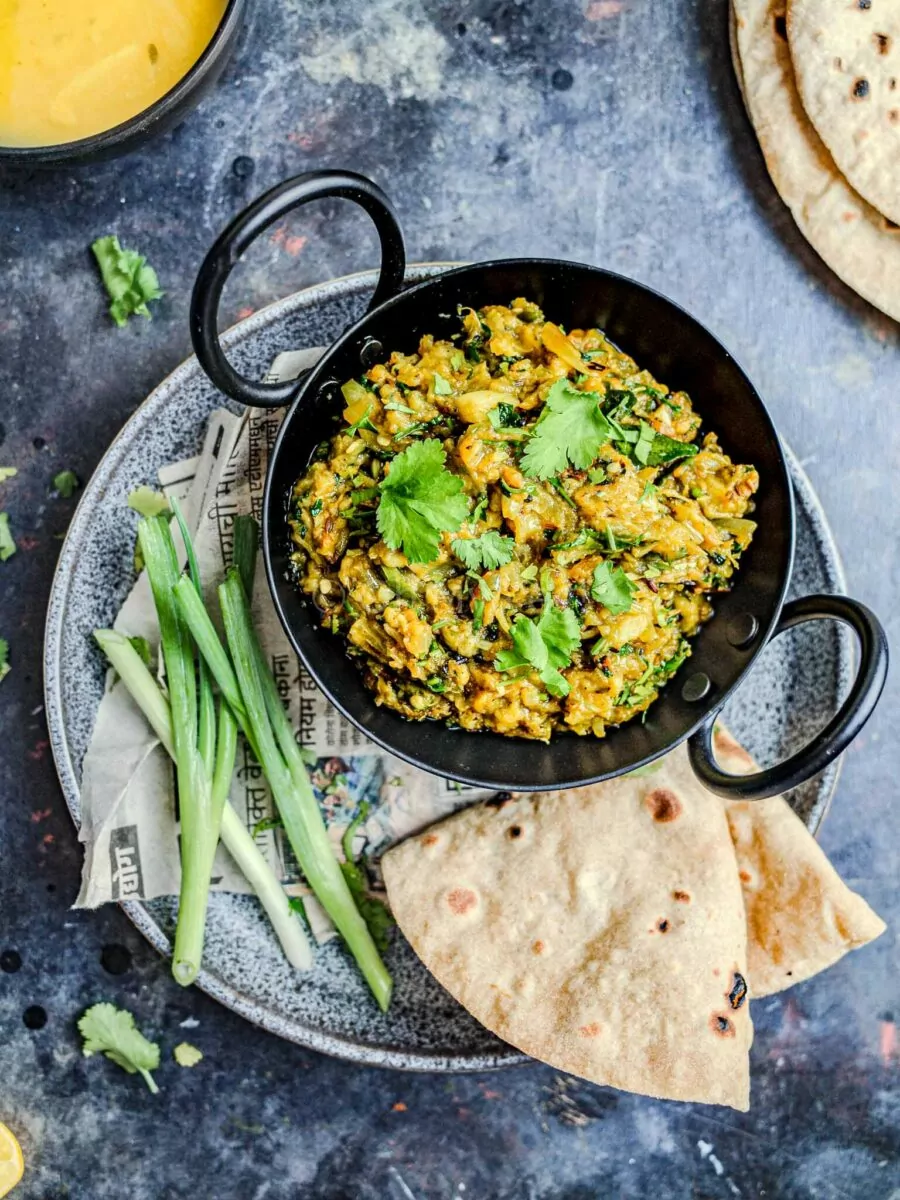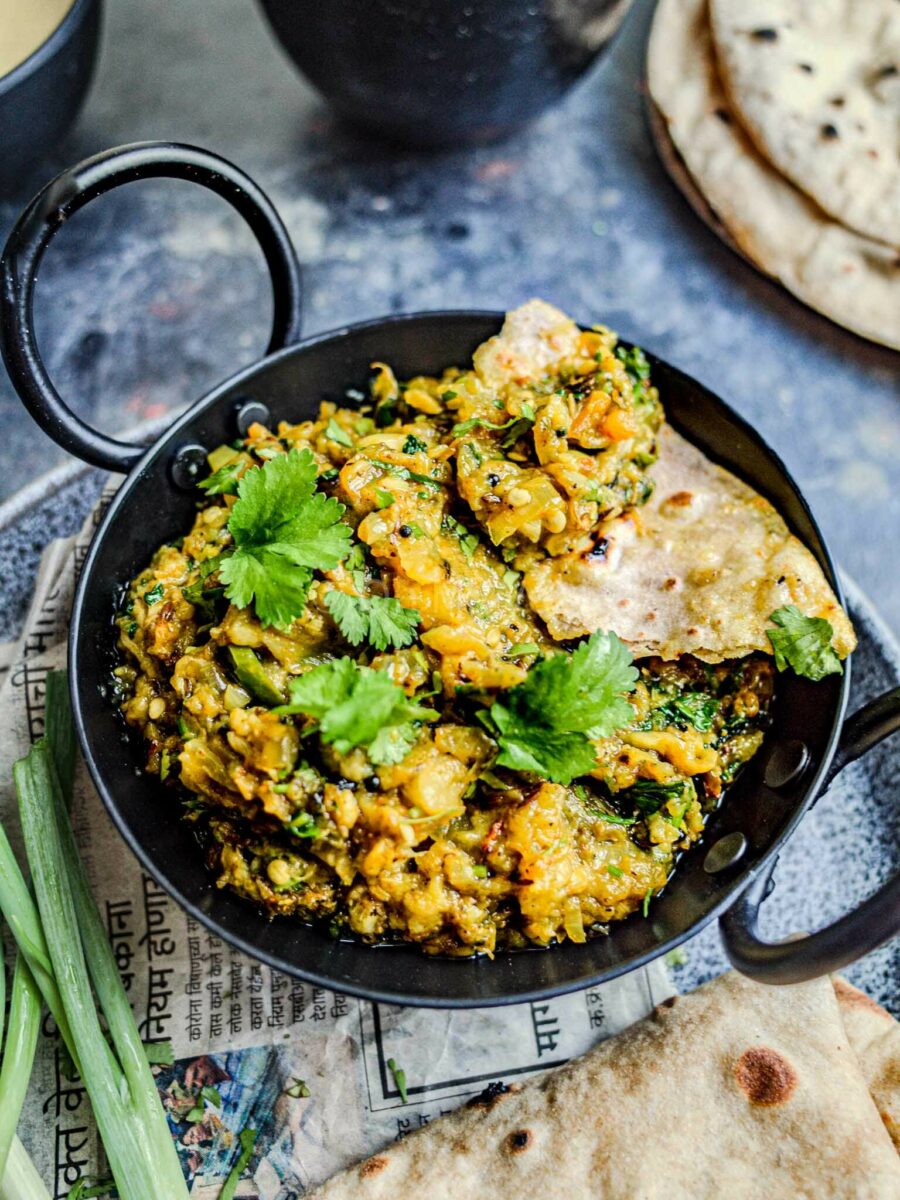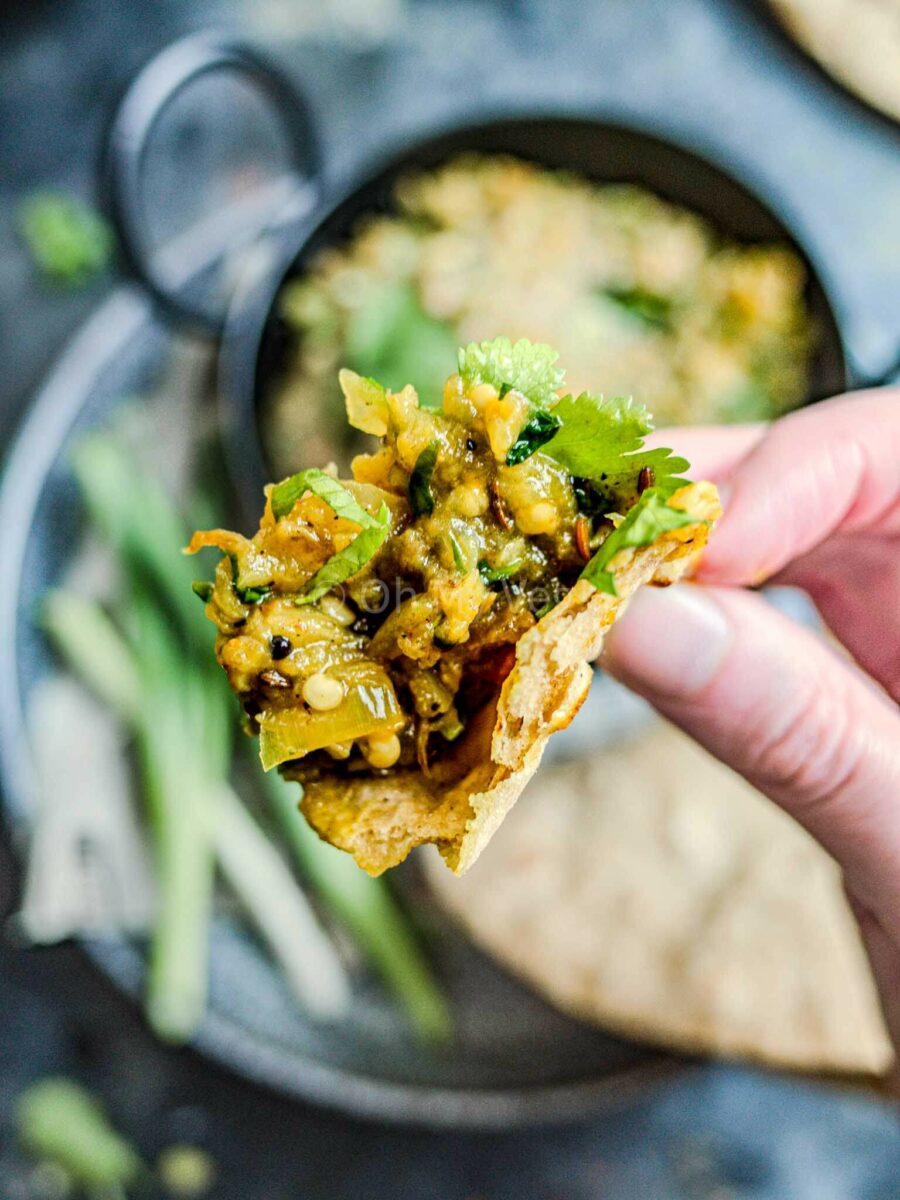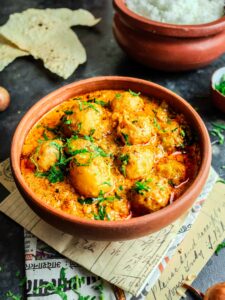Vangyache Bharit, Maharashtrian Smoky Aubergine Curry

Some dishes are so scrumptious they can convert haters. For example, okra fries are a must-try for anyone on the fence about okra (they’re not slimy, I promise), while Punjabi chole will transform any chickpea hater into a fan. And this vangyache bharit? Well, it’s so delicious that even sworn aubergine (or eggplant, for my U.S. readers) cynics come around.
In my household, vangyache bharit is a weekly affair. This Maharashtrian dish is a staple for a reason: the aubergine, roasted directly on the flame, becomes intensely smoky, soft, and buttery. It’s mixed with fresh spices, caramelized onion chunks, and juicy tomato — similar to baba ganoush, but dare I say it, even better. Along with bharli vangi, this is by far my favorite way to prepare aubergine.
Furthermore, vangyache bharit is quick and easy to prepare (it takes less than 30 minutes from start to finish), plus naturally 100% vegan, nut-free, and gluten-free. I love impressing family and friends with this unique spin on baingan bharta!
Vangyache Bharit vs Baingan Bharta
Roasted aubergine dishes are ubiquitous across India — they have different names plus regional variations on ingredients and preparation techniques, but the heart of the recipe is the same.
The most well-known of these regional variations is baingan bharta, from Punjab. In Bengal, the dish is known as baigan bhorta, and is almost exclusively cooked in mustard oil, while in neighboring Bihar and UP, it’s called baigan chokka and accompanied by litti. In Gujarat, it’s famous as ringna no olo. Of course, there are countless other forms, from Kashmir to Tamil Nadu … all delicious.
Cooking oils, souring ingredients (yogurt or tamarind, usually), and even whether the aubergine is tempered, fried, or mixed with cold ingredients, like Middle Eastern baba ganoush are all points of difference.
This Maharashtrian version boasts strong yet fresh flavors. Unlike the Punjabi baingan bharta, it doesn’t use many dry or powdered spices, instead relying on the heat from green chilis and pungent, citrusy curry leaves. Additionally, vangyache bharit is less tomato-heavy and finished with a smoky touch of a regional spice blend called goda masala.

Ingredients for Vangyache Bharit
Unlike Punjabi recipes like malai kofta or shahi paneer, this vangyache bharit recipe has a much shorter, simpler ingredient list. It’s punctuated by the boldness of umami in the roasted ingredients, and lightly seasoned, allowing the fresh ingredients to do the talking.
- Aubergine (also called eggplant, brinjal, or in Marathi, vangi) is the heart of this Maharashtrian baingan bharta. For the 100% authentic flavor, I recommend searching for large green aubergines. However, living in the U.K., I typically use purple globe aubergines.
- Garlic melts into a buttery, mellow, and sweet flavor when roasted.
- Green chili provides heat to this recipe. I don’t add dried chili powder; the fresh finger chilis provide a more intense, citrusy flavor.
- Tomato adds a sour note to the bharit. I roast the tomatoes, which brings out a powerful tangy, umami, deeply savory flavor.
- Onion adds bulk and a gentle caramelized sweetness to the vangi bharit.
- Oil is a flavor carrier, vital for drawing out the aromas of the spices.
- Black mustard seeds pop in the mouth, imparting a bitter and spicy bite.
- Cumin seeds are a warm, earthy spice.
- Curry leaves have a uniquely zesty aroma and taste. Use fresh, not dried.
- Turmeric powder is mostly used for color in this recipe, so you can skip it if need be.
- Coriander powder is optional but builds on the lemony flavors of curry leaves.
- Goda masala is a smoky, aromatic, earthy Maharashtrian spice blend with a sweet aroma. It lends a lot of flavor to this vangyache bharit, but in a pinch, you can substitute garam masala.
- Fresh coriander (cilantro) lifts the dish with a fresh, citrusy, herby pop.
In some areas of Maharashtra such as Khandesh and Marathwada, home cooks like to add crushed peanut powder to the vangyache bharit. Moreover, in the Konkan region (along the coast), chefs add roasted coconut, beloved for its sweet, nutty profile. You can add either of these; I keep it simple in this recipe, which is based on Vidharba-style cooking.

How to Make Vangyache Bharit
Once you know how, making Maharashtrian vangyache bharit is surprisingly straightforward. It only takes around 30 minutes! You can find more detailed instructions in the recipe card below, but this is a good overview:
- Roast the aubergine on a gas hob* until the skin blackens and blisters. Remove from the heat, peel the skin off, and mash the flesh.
- Also roast the garlic, onion, tomato, and green chilis until they blister. Finely chop and mix with the aubergine.
- Temper the mustard seeds, cumin seeds, and curry leaves in hot oil. Add the roasted ingredients, turmeric powder, and coriander powder. Cook.
- Finish with a pinch of goda masala and fresh coriander.
*Alternative Cooking Methods
Don’t have a gas hob? No problem!
Ideally, you want to roast your aubergine over an open flame or coals to achieve the characteristic smoky char that makes vangyache bharit incredibly irresistible. That’s why the best method is on a barbecue — this will taste even better than using a gas hob!
However, you can roast the aubergine whole in the oven. While it won’t achieve the same aroma or taste, you can replicate this using the dhungar method. Burn a piece of natural charcoal until it glows, then place it in a small pot in the same cooking vessel as your vangyache bharit. Pour ghee over the charcoal, causing it to smoke, and cover the bharit with a lid. This will infuse an unbelievably tempting smoky aroma.
Cookware You Need

My cooking method is completely different from any other recipe you’ll find online. While most suggest roasting the garlic along with the aubergine, what sets this recipe apart is also roasting the onion, tomato, and green chili. It heightens the flavors of each of the ingredients, infusing the vangyache bharit with unprecedented levels of umami-rich savoriness.
How to Serve Vangyache Bharit
Vangyache bharit isn’t complete without a smattering of fresh and lemony coriander leaves, spring onion to munch on, and a wedge of lemon — if you’re so inclined. But what about side dishes?
Most people (including me!) love to serve vangyache bharit with bread. There are a few options:
- Maharashtrian baingan bharta with bhakri is a beloved traditional combination, especially in villages and rural areas. Bharit bhakri is rustic and homely — plus, since jowar bhakri (the most common choice) is made from sorghum flour, it’s healthy and gluten-free, too.
- Garlic naan pairs wonderfully with vangyache bharit, mimicking a restaurant-style meal.
- My go-to complimentary bread is puffy and hot ghee-soaked chapatis (known as poli in Marathi) which are ideal for mopping up the semi-dry smoky aubergine curry.
- A less traditional way to serve vangyache bharit is with methi paratha or plain layered paratha.
Of course, Maharashtrian baingan bharta also tastes wonderful atop fluffy steamed rice or jeera rice. Making a pot of steaming hot varan — Maharashtrian toor dal with cumin seeds, garlic, and curry leaves — is obligatory.
If you want to go all-out with an Indian feast for curry night, consider showcasing the vangyache bharit with dal tadka, raita, papads, bhindi masala, and batatyacha rassa.
This Recipe Is:

Vangyache Bharit
This Maharashtrian vangyache bharit recipe highlights mashed, smoky aubergine with fresh spices. It's perfect with chapati/roti and dal.
Ingredients
- 1 Large Aubergine (Eggplant/Brinjal/Vangi)
- 4 Garlic Cloves
- 2 Large Finger Chilis
- 1/2 Onion
- 1/2 Tomato
- 2 tbsp Neutral Oil
- 1/4 tsp Black Mustard Seeds
- 1/2 tsp Cumin Seeds
- Small Sprig Curry Leaves (about 10)
- 1/8 tsp Turmeric Powder
- 1/2 tsp Coriander Powder
- Salt, to taste
- 1/4 tsp Goda Masala
- Fresh Coriander to serve, optional
Instructions
- Roast the aubergine whole. Open your windows and turn on your extractor fan. Peel the leaves off the top of the aubergine to avoid burning. Place the aubergine on the largest ring of your gas hob, and roast over medium heat until the skin is completely blackened and blistering. You will have to turn it halfway through cooking. This should take around 10 minutes. Set to rest on a plate.
- Roast the other ingredients. Using a steel wire roasting rack, roast the garlic, onion, tomato, and green chilis individually until they blister.
- Peel the skin off the aubergine and mash the flesh along with the garlic, onions, tomatoes, and green chilis.
- In a kadai or large pan, heat neutral oil over medium heat. Add the mustard seeds and wait for them to pop. Next, add the cumin seeds and curry leaves (be careful, these can spit!). Once they splutter, add the roasted and mashed ingredients to the pan along with turmeric and coriander powder. Mix well.
- Season with salt and allow to cook for 5 minutes.
- Finish with a pinch of goda masala and freshly chopped coriander. The vangyache bharit tastes fantastic served with a dollop of ghee or vegan butter.
Notes
* If you don't have a gas hob, you can oven roast or barbecue the aubergine.
Nutrition Information:
Yield: 2 Serving Size: 1Amount Per Serving: Calories: 840Total Fat: 49gSaturated Fat: 12gTrans Fat: 0gUnsaturated Fat: 27gCholesterol: 101mgCarbohydrates: 65gFiber: 12gSugar: 18gProtein: 6g
Nutrition information isn’t always accurate.









